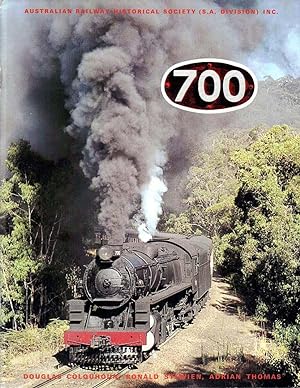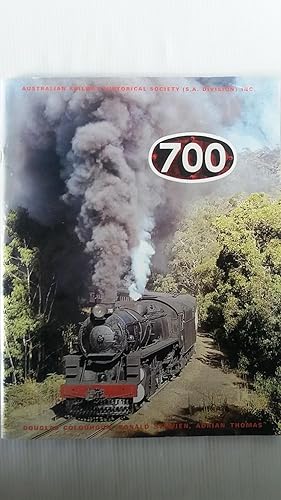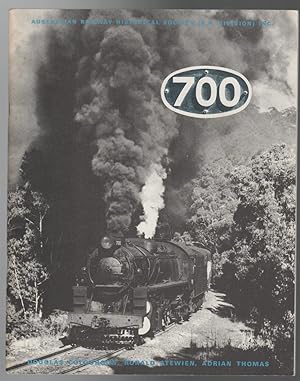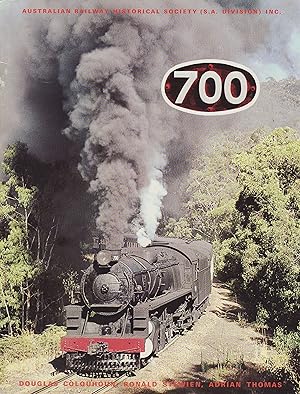COLQUHOUN, ADRIAN (20 Ergebnisse)
Produktart
- Alle Produktarten
- Bücher (20)
- Magazine & Zeitschriften
- Comics
- Noten
- Kunst, Grafik & Poster
- Fotografien
- Karten
-
Manuskripte &
Papierantiquitäten
Zustand
Einband
- alle Einbände
- Hardcover
- Softcover (17)
Weitere Eigenschaften
- Erstausgabe (3)
- Signiert
- Schutzumschlag
- Angebotsfoto (6)
- Kein Print-on-Demand (14)
Land des Verkäufers
Verkäuferbewertung
-
700 The '700' Series of Steam Locomotives of the South Australian Railways
Verlag: Australian Railway Historical Society (S.A. Division) Inc., Adelaide SA,, 1979
Anbieter: lamdha books, Wentworth Falls, NSW, Australien
Quarto; paperback, stapled brochure; 53pp., with many colour and monochrome illustrations and a folding monochrome plate. Minor wear; covers mildly rubbed. Very good. Postage quoted is for a standard format octavo book. Final charges may vary depending on size and weight.
-
The 700 Series Locomotives of the South Australian Railways
Verlag: Alustralian Railway Historical Society ( S.A. Division ) Inc, Adelaide, 1979
Anbieter: Your Book Soon, Stroud, GLOS, Vereinigtes Königreich
Buch Erstausgabe
Soft cover. Zustand: Very Good. 1st Edition. 52 pp numerous illustrations some in colour, staple bound in card covers. Corners a little rubbed otherwise clean and sound.
-
700 The '700' Series Locomotives Of The South Australian Railways.
Verlag: Walkerville, SA; Australain Railway Historical Society (S. A. Division ) Inc.; 1968., 1968
Anbieter: Time Booksellers, Somerville, VIC, Australien
First Edition; Demy 4to; pp. 40; profusely illustrated through with photographs and diagrams, 1 fold-out illustration being a scale drawing of the 700 Class Mikado, bound in original stiff stapled illustrated wrapper, spine browned, otherwise a very good copy.
-
Microsoft SharePoint 2010 Power User Cookbook
Verlag: Packt Publishing, 2011
ISBN 10: 1849682887ISBN 13: 9781849682886
Anbieter: HPB-Red, Dallas, TX, USA
Buch
paperback. Zustand: Good. Connecting readers with great books since 1972! Used textbooks may not include companion materials such as access codes, etc. May have some wear or writing/highlighting. We ship orders daily and Customer Service is our top priority!.
Mehr Angebote von anderen Verkäufern bei AbeBooks
Neu ab EUR 46,37
Gebraucht ab EUR 41,18
Mehr entdecken Softcover
-
Proceed to Peterborough : The Last of Steam on the Soth Australian Railways
Verlag: Australian Railway Historical Society (SA Division) Inc.1970., 1970
Anbieter: Alexander Fax Booksellers, Mawson, ACT, Australien
Stapled quarto soft covers, 53pp, b&w photos (plus three in colour). Light wear to cover edges; a very good copy.
-
700 : The 700 Series Locomotives of the South Australian Railways
Verlag: Australian Railway Historical Society (SA), Adelaide, South Australia, Australia, 1968
Anbieter: Train World Pty Ltd, North Brighton, VIC, Australien
Buch Erstausgabe
Soft cover. Zustand: Good. No Jacket. 1st Edition. 40 pages b/w photos - The first South Australian Railways 700 Class locomotives were built during the mid 1920s in Great Britain by the Armstrong Whitworth Company and were used as main line freight locomotives, releasing the aged small power Rx-class fleet for shunting and branch line services. The difference in power between these two classes can be gauged by the fact that a 700 could lift 390 tons over Mt Lofty while an Rx could manage only 190 tons. The 700-class Mikado type locomotive proved so successful that another ten were ordered, this time from the SAR's own Islington Workshops. Though dimensionally similar to the original engines they differed in some minor details and as a result were classified 710. Unfortunately the Mikado fleet were all sent to the breakers yard for scrap metal during the 1960s. One example of the Class survives as a static exhibit at the National Railway Museum at Port Adelaide.
-
Proceed to Peterborough : The Last of Steam on the South Australian Railways
Verlag: Australian Railway Historical Society (SA), Adelaide, South Australia, Australia, 1970
Anbieter: Train World Pty Ltd, North Brighton, VIC, Australien
Buch Erstausgabe
Soft cover. Zustand: Good. No Jacket. 1st Edition. 54 pages colour and b/w photos - Peterborough sits on the intersection of the East-West railway linking Port Pirie and Broken Hill, and the North-South railway linking Adelaide eventually to Alice Springs via Quorn, both narrow gauge (1,067 mm (3 ft 6 in)) lines. The line from Port Pirie and Jamestown arrived in 1881, followed shortly after by the line from Terowie in the south. The line to Broken Hill was completed in 1887.[5] Peterborough was the home town for Bob the Railway Dog who is remembered by a bronze statue located in the Main Street. In 1970, the East-West line was converted to standard gauge (1,435 mm (4 ft 8 1/2 in)), and the line south of Peterborough to Terowie to broad gauge (1,600 mm (5 ft 3 in)). Thus Peterborough became one of three, triple-gauge railway junctions in Australia. The others being Gladstone and Port Pirie, all on the same railway corridor.
-
500 : The 4-8-2 and 4-8-4 Locomotives of the South Australia Railways
Verlag: Australian Railway Historical Society (SA), Adelaide, South Australia, Australia, 1979
Anbieter: Train World Pty Ltd, North Brighton, VIC, Australien
Buch
Soft cover. Zustand: Good. No Jacket. 2nd Edition. 48 pages b/w photos - The beginnings of the railway were in the Port Adelaide railway line. This suburban main line linked the harbour area of Port Adelaide to the colony, and was laid with Irish gauge 1,600 mm (5 ft 3 in) track. This line was opened in 1856. Later on, branch lines in the state's north in the mining towns of Kapunda and Burra were linked through to the Adelaide metropolitan system. From here, a south main line extended to meet the horse tramway from Victor Harbor to Strathalbyn, and towards to SA/Victorian Border. With the metropolitan systems being broad gauge, the mid north and south east of the state were originally laid with 1,067 mm (3 ft 6 in) narrow gauge track. These systems were closely based on British practice, as was the broad gauge system prior to 1926. Locomotives and rolling stock were bought from Britain and the USA, from builders such as Beyer, Peacock and Company, Dübs and Company, their successors, the North British Locomotive Company, and Baldwin Locomotive Works. Nine broad gauge tank locomotives plus the frame of a tenth were bought second-hand from the Canterbury Provincial Railways in New Zealand when it converted to narrow gauge. In 1922, after the SAR's worst financial deficit, the government appointed American railroad manager William Webb, from the Missouri-Kansas-Texas Railroad (the KATY, for short) as Chief Commissioner. When Webb arrived in Adelaide with his young family, he found a railway system unchanged since the late 19th Century. The locomotives and rolling stock were small, wagons and carriages were of wooden construction, the track and bridges were unsuitable for heavy loads, the workshops had antiquated machinery and the signaling system was inflexible. These attributes drove up the ratio of operating costs to revenue. Webb introduced a rehabilitation plan based on American railroad princilpes of large, standardised locomotives and steel bodied freight wagons, with automatic couplers to enable a significant increase in productivity. Lightly patronised passenger trains would be replaced by self propelled rail cars, enabling faster, more frequent and more efficient services. He recruited Fred Shea as his Chief Mechanical Engineer and had him prepare specifications for this new equipment. This resulted in orders being placed for 1,200 wagons of four types from American Car and Foundry, 12 petrol mechanical railmotor cars from the Service Motors Corporation, Wabash, Indiana, and 30 locomotives based on ALCO plans but built by Armstrong Whitworth & Co. in the UK. These were of the Mountain, Pacific and Mikado wheel arrangements, 10 of each type, which became the 500, 600, and 700, class locomotives. To carry the heavier trains, the rehabilitation plan included the strengthening of track and bridges, and the conversion of the mid north narrow gauge system (the Western division) to broad gauge. The antiquated Islington Workshops were demolished and replaced with a thoroughly modern railway maintenance and manufacturing works, a large new round house was built at Mile End, near Adelaide, and several 85 foot turntables were installed throughout the state to enable the much larger locomotives to be turned. Efficient train operations were facilitated by the adoption of American train order working on country lines, and Adelaide railway station was replaced with an imposing new building, opened in 1927. This grand building now acts as the casino of Adelaide. When the two shiploads of new locomotives arrived in 1926 they caused a sensation with the public and throughout the railway industry in Australia. The 500 class "Mountain" was over twice the size of the biggest pre-Webb engine, and was the most powerful locomotive in Australia. Henceforth double heading broad gauge trains became a rarity in South Australia. The massive locomotives were unloaded at Port Adelaide and taken off the pier by horses (the locomotives weight alone exceeding the docks maximum loading capacity). Apart fr.
-
500: The 4-8-2 and 4-8-4 Locomotives of the South Australia Railways
Verlag: Australian Railway Historical Society (SA), Adelaide, South Australia, Australia, 1979
Anbieter: Train World Pty Ltd, North Brighton, VIC, Australien
Buch
Soft cover. Zustand: Good. No Jacket. 2nd Edition. 48 pages b/w photos - The beginnings of the railway were in the Port Adelaide railway line. This suburban main line linked the harbour area of Port Adelaide to the colony, and was laid with Irish gauge 1,600 mm (5 ft 3 in) track. This line was opened in 1856. Later on, branch lines in the state's north in the mining towns of Kapunda and Burra were linked through to the Adelaide metropolitan system. From here, a south main line extended to meet the horse tramway from Victor Harbor to Strathalbyn, and towards to SA/Victorian Border. With the metropolitan systems being broad gauge, the mid north and south east of the state were originally laid with 1,067 mm (3 ft 6 in) narrow gauge track. These systems were closely based on British practice, as was the broad gauge system prior to 1926. Locomotives and rolling stock were bought from Britain and the USA, from builders such as Beyer, Peacock and Company, Dübs and Company, their successors, the North British Locomotive Company, and Baldwin Locomotive Works. Nine broad gauge tank locomotives plus the frame of a tenth were bought second-hand from the Canterbury Provincial Railways in New Zealand when it converted to narrow gauge. In 1922, after the SAR's worst financial deficit, the government appointed American railroad manager William Webb, from the Missouri-Kansas-Texas Railroad (the KATY, for short) as Chief Commissioner. When Webb arrived in Adelaide with his young family, he found a railway system unchanged since the late 19th Century. The locomotives and rolling stock were small, wagons and carriages were of wooden construction, the track and bridges were unsuitable for heavy loads, the workshops had antiquated machinery and the signaling system was inflexible. These attributes drove up the ratio of operating costs to revenue. Webb introduced a rehabilitation plan based on American railroad princilpes of large, standardised locomotives and steel bodied freight wagons, with automatic couplers to enable a significant increase in productivity. Lightly patronised passenger trains would be replaced by self propelled rail cars, enabling faster, more frequent and more efficient services. He recruited Fred Shea as his Chief Mechanical Engineer and had him prepare specifications for this new equipment. This resulted in orders being placed for 1,200 wagons of four types from American Car and Foundry, 12 petrol mechanical railmotor cars from the Service Motors Corporation, Wabash, Indiana, and 30 locomotives based on ALCO plans but built by Armstrong Whitworth & Co. in the UK. These were of the Mountain, Pacific and Mikado wheel arrangements, 10 of each type, which became the 500, 600, and 700, class locomotives. To carry the heavier trains, the rehabilitation plan included the strengthening of track and bridges, and the conversion of the mid north narrow gauge system (the Western division) to broad gauge. The antiquated Islington Workshops were demolished and replaced with a thoroughly modern railway maintenance and manufacturing works, a large new round house was built at Mile End, near Adelaide, and several 85 foot turntables were installed throughout the state to enable the much larger locomotives to be turned. Efficient train operations were facilitated by the adoption of American train order working on country lines, and Adelaide railway station was replaced with an imposing new building, opened in 1927. This grand building now acts as the casino of Adelaide. When the two shiploads of new locomotives arrived in 1926 they caused a sensation with the public and throughout the railway industry in Australia. The 500 class "Mountain" was over twice the size of the biggest pre-Webb engine, and was the most powerful locomotive in Australia. Henceforth double heading broad gauge trains became a rarity in South Australia. The massive locomotives were unloaded at Port Adelaide and taken off the pier by horses (the locomotives weight alone exceeding the docks maximum loading capacity). Apart fr.
-
700 : The 700 Series Locomotives of the South Australian Railways
Verlag: Australian Railway Historical Society (SA), Adelaide, South Australia, Australia, 1979
ISBN 10: 0959850945ISBN 13: 9780959850949
Anbieter: Train World Pty Ltd, North Brighton, VIC, Australien
Buch
Soft cover. Zustand: Very Good. No Jacket. 2nd Edition. 52 Pages with Black/White Photos. The first South Australian Railways 700 Class locomotives were built during the mid 1920s in Great Britain by the Armstrong Whitworth Company and were used as main line freight locomotives, releasing the aged small power Rx-class fleet for shunting and branch line services. The difference in power between these two classes can be gauged by the fact that a 700 could lift 390 tons over Mt Lofty while an Rx could manage only 190 tons. The 700-class Mikado type locomotive proved so successful that another ten were ordered, this time from the SAR's own Islington Workshops. Though dimensionally similar to the original engines they differed in some minor details and as a result were classified 710. Unfortunately the Mikado fleet were all sent to the breakers yard for scrap metal during the 1960s. One example of the Class survives as a static exhibit at the National Railway Museum at Port Adelaide.







